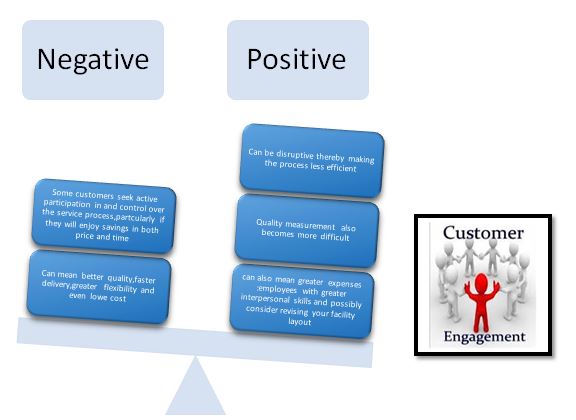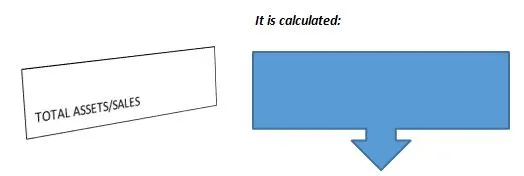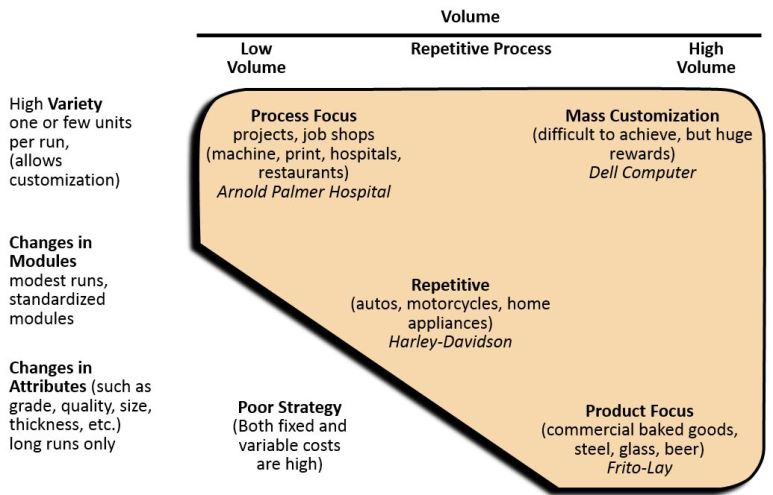(Marta Alarcón & Jorge Moreno)
A process (or transformation) strategy is an organization’s approach to transforming resources into goods and services.
The objective of a process strategy is to build a production process that meets customer requirements and product specification within cost and other managerial constraints.
The process selected will have a long term effect on efficiency and flexibility of production as well as on cost and quality of the goods produced. Therefore the limitations of a process strategy are at the time of the process decision.

In understanding Process strategy there are three principles that are particularly important:
- The key to successful process decisions is to make choices that fit the situation. They should not work at cross-purposes, with one process optimized at the expense of other processes. A more effective process is one that matches key process characteristics and has a close strategic fit.
- Individual processes are the building blocks that eventually create the firm’s whole supply chain.
- Management must pay close attention to all interfaces between processes in the supply chain, whether they are performed internally or externally.
It can be utilized to guide a variety of process decisions, operations strategy, and your business’ ability to obtain the resources necessary to support them.
A process involves the use of an organization’s resources to provide something of value.
Major process decisions include:
- Process Structure determines how processes are designed relative to the kinds of resources needed, how resources are partitioned between them, and their key characteristics.
- Customer Involvement refers to the ways in which customers become part of the process and the extent of their participation.

It is Manager’s job to assess whether the advantages outweigh disadvantages, judging them in terms of the competitive priorities and customer satisfaction. Customer involvement is not always the best option as there are disadvantages commonly associated with it. For example, allowing customers to play an active role in a service process can be disruptive thereby making the process less efficient.
Quality measurement also becomes more difficult to manage.
Additionally, customer involvement in processes can also mean greater expenses for your business as you will require employees with greater interpersonal skills and possibly consider revising your facility layout. However, despite these possible disadvantages, the advantages of a more customer-focused Customer involvement process might increase the net value to your customer. Some customers seek active participation in and control over the service process, particularly if they will enjoy savings in both price and time. More customer involvement can mean better quality, faster delivery, greater flexibility, and even lower cost.
- Resource flexibility is the ease with which employees and equipment can handle a wide variety of products, output levels, duties, and functions.

We consider resource flexibility mainly at two levels:
- Workforce
One of the decisions and operations manager has to make is whether or not to have a flexible workforce, that is, employees that are capable of doing many tasks.
The type of workforce you require is also dependent on the need for volume flexibility. For example, when conditions allow for a smooth, stead rate of output, the likely choice is a permanent workforce that expects regular full-time employment.
Alternatively, if the process is subject to hourly, daily, or seasonal peaks and valleys in demand, the use of part-time or temporary employees to supplement a smaller core of full-time employees may be the best solution

- Equipment
When a firm’s product or service has a short life cycle and a high degree of customization, low production volumes mean that a firm should select flexible, inexpensive, general-purpose equipment. When volumes are low, the low fixed cost more than offsets the higher variable unit cost associated with this type of equipment. Conversely, specialized, higher-cost equipment is the best choice when volumes are high and customization is low. Its advantage is low variable unit cost
- Capital intensity is the mix of equipment and human skills in a process.

It is calculated: total assets of a company/sales of the company.
A higher capital intensity ratio for a company means that the company needs more assets than a company with lower ratio to generate equal amount of sales. A high capital intensity ratio may due to lower utilization of the company’s assets or it may be because the company’s business is more capital intensive and less labor intensive (for example, because it is automated). However, for companies in the same industry and following similar business model and production processes, the company with lower capital intensity is better because it generates more revenue using less assets.
There are four process strategies:
- Process Focus
- Repetitive Focus
- Product Focus
- Mass Customization

